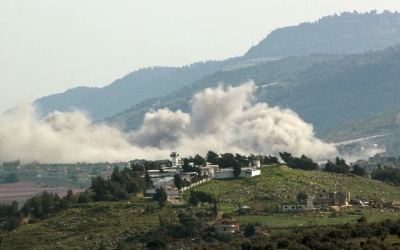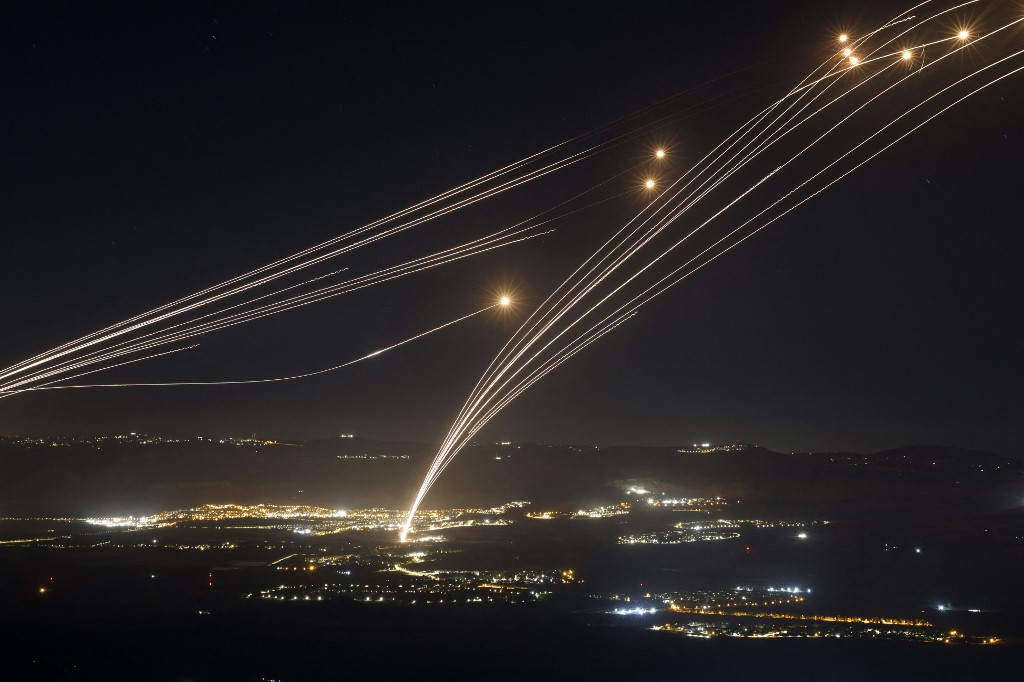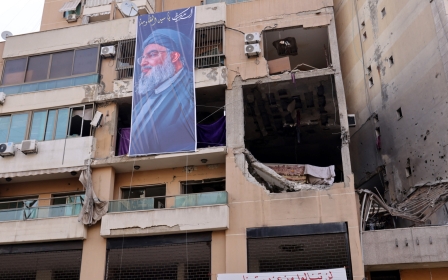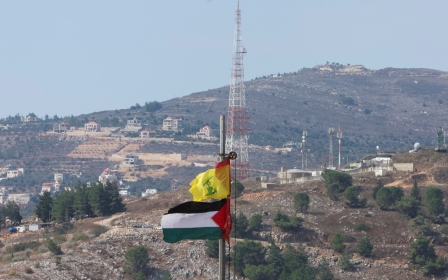How Israel-Lebanon conflict could redefine modern warfare

With the recent spate of confirmed and alleged assassinations and decapitation strikes in Beirut, Tehran and Khan Younis, the likelihood of a third war between Israel and Hezbollah has markedly increased.
Both adversaries are expected to extensively deploy unmanned aerial vehicles (UAVs), or drones, of various types in a war on their doorstep.
In April, I wrote an article discussing Hezbollah’s military capabilities.
At that time, I harboured hopes for a "peace-by-terror" scenario, wherein conventional deterrence would prevail and prevent or postpone the outbreak of a full-scale war. Back then, Israel's posture along the Lebanese border was primarily defensive.
However, as forecast, this stance swiftly transitioned to an offensive one.
New MEE newsletter: Jerusalem Dispatch
Sign up to get the latest insights and analysis on Israel-Palestine, alongside Turkey Unpacked and other MEE newsletters
This offensive posture has been reinforced by the redeployment of units from Gaza, including brigades from the 36th Regular Division of the Northern Command. This is the same division that previously bisected Gaza into northern and southern parts, fighting its way to the Mediterranean to establish the Netzarim corridor.
Additionally, brigades from the elite 98th Paratroopers Division (regulars) and the 146th Reserve Division have been redeployed or newly positioned in the north.
The current combat grouping of three divisions - 12 brigades - is roughly twice the size of Israel’s invading force in July 2006.
Spying on the spies
At the time of writing, only some of the assault brigades of these divisions were reported to be in their positions. Nonetheless, to avoid the debacles of the 2006 war and to successfully push Hezbollah’s tenacious units over the Litani river towards the north, the Israeli army will require substantial additional manpower.
To effectively undermine the Israeli military's operational objectives, Hezbollah is likely to intensify drone warfare and employ several types of UAVs - including fixed-wing, multi-rotor, loitering munitions and first-person-view - as a force multiplier against superior Israeli forces.
Follow Middle East Eye's live coverage of the Israel-Palestine war
How may Hezbollah employ drones during a potential third war? Well, here is an analytical review.
In July 2006, Hezbollah managed to intercept and decrypt the video feeds and communications of Israeli drones by employing a combination of electronic warfare techniques, signals intelligence and ground-based interceptions.
This infiltration allowed them to gain real-time intelligence on the Israeli army’s operational plans and units’ movements in southern Lebanon.
Hezbollah's fighters mined and booby-trapped some of the targeted locations, and the organisation's 'tank-killing' teams were ready
Hezbollah did not disrupt the feeds. Instead, its units spied on the “flying spies” - the Israeli army’s surveillance drones. Identifying the targeted locations, Hezbollah’s combat units prepared ambushes for the Israeli army’s assault units.
Hezbollah’s fighters mined and booby-trapped some of the targeted locations, and the organisation’s “tank-killing” teams were ready with both anti-tank guided missiles and unguided rockets.
All these preparations were based on real-time movement seen in the drone feeds. Moreover, Hezbollah repositioned its forces to better withstand Israeli attacks and pre-registered/pre-arranged their indirect fires, such as rocket artillery and mortars, for greater precision by knowing the locations and movements of the Israeli army units.
Overall, in 2006, Hezbollah executed a textbook counter-drone operation that bled the Israeli army in deadly ambushes.
Ground-based lethality
Hezbollah is not the same 2006 force. The organisation’s current military capabilities are superior to the vast majority of non-state forces, and to several small-states’ ground forces.
Ground forces still dominate Hezbollah’s military capabilities. They include various types of infantry, special forces, armour, artillery and ground-based air defences.
Hezbollah’s ground-based lethality was exhibited by its anti-armour infantry teams in 2006.
These teams have caused the highest percentage of Israeli military fatalities in Lebanon (over 28 percent by my estimates), compared with other units and branches, including rocket- and mortar-artillery, improvised explosive devices, sniping; and even compared with Israeli friendly fire, which resulted in about 12 percent of the Israeli army’s fatalities.
The organisation is also capable in the electronic, cyber and intelligence/information domains, and less so in the sea domain.
The capabilities in the air domain of operations have been steadily, but unconventionally, advancing. In 2006, indirect fire from rockets and missiles resulted in more civilian losses in Israel than military losses in Lebanon, due to inaccuracy and other reasons.
In 2024, the level of precision (as well as ranges and payloads) has significantly changed. That is due - in part - to Hezbollah’s unmanned air force.
Although Hezbollah had a history of basic UAV employment even before the 2006 war, the organisation has demonstrated a relatively new capability in 2024: it can “see” deep into Israel.
“Seeing” in military terminology translates to “intelligence, surveillance and reconnaissance” (ISR). Hezbollah successfully executed multiple air-domain breaches, where military-grade UAVs have penetrated deep into Israeli airspace to gather intelligence and perform surveillance and reconnaissance operations.
Remote capability
Targeted locations were not just soft ones. They included the well-defended Ramat David Airbase and an Israeli naval base in Haifa, as well as several warships and infrastructure of the navy’s submarine unit, Shayetet 7.
The operations demonstrated Hezbollah’s remote capability to conduct surveillance over Israeli air force and naval bases, as well as urban centres.
If, or when, war breaks out, these ISR UAVs will likely transmit their targets’ location coordinates to rocket-artillery batteries, missile units, combat UAVs and/or loitering munitions (one-way or “suicide” drones) for precision strikes.
In a way, this mimics what Russia’s Orlan-10 ISR UAVs and Lancet loitering munitions are doing in Ukraine. The coordination between Russia’s ISR and combat UAVs and missile units might have resulted in defeating and destroying two Patriot launchers - two components of one of the world’s most capable and most expensive air-defence systems - by Russian occupation forces in Ukraine.
In an ironic way, Hezbollah might be following an old Anglo-American military adage: 'If it can be seen, it can be hit. If it can be hit, it can be killed'
In an ironic way, Hezbollah might be following an old Anglo-American military adage: “If it can be seen, it can be hit. If it can be hit, it can be killed.” Hezbollah’s problem of blind rocket artillery and inaccurate indirect fires is fading away, partly due to UAVs.
The remote capabilities are not limited to ISR, though.
The organisation conducted remote strikes deep into Israel, most recently in August 2024. Multiple drones were able to penetrate northern Israel, resulting in the wounding of Israeli soldiers and civilians. The attacks underlined the dual-use nature of Hezbollah's drone fleet for both surveillance and strike operations.
Generally, the impacts of UAVs on warfare are still vehemently debated among military and security experts. Still, for Hezbollah and the Israeli army alike, drones will exert significant tactical and likely operational impacts in the anticipated conflict.
So far, UAVs - regardless of their types - are not a strategic category of weapon systems; it is very unlikely that they will decide the outcome of the war.
Remarkable advancement
Even on the operational level of war, Hezbollah faces challenges in developing, structuring and employing its unmanned air force.
Currently, the organisation cannot field and sustain the large UAV swarms necessary to achieve air superiority below 3,000 feet, and therefore deliver substantial air attacks.
With UAV swarms, Hezbollah would grapple with the issues of destructive frequency interference, electronic warfare fratricide and Israel’s advanced electronic attacks.
Without UAV swarms and their advantages, Hezbollah’s combat effectiveness and lethality levels in the air domain may remain limited, especially when compared with its anti-tank infantry teams or even its unguided rocket artillery.
This holds true even with the deployment of military-grade loitering munitions when operating solo or in small numbers.
Nevertheless, Hezbollah’s UAV capabilities are evolving. Solutions to the current challenges are a matter of will, skill and time.
Presently, UAVs have already provided Hezbollah with unprecedented stealthy reconnaissance capabilities over Israel and enhanced intermittent precision targeting. This represents a remarkable advancement, once deemed an impossibility just a couple of decades ago.
The evolution of drone warfare in this conflict and beyond is far from over. As Hezbollah continues to refine and expand its UAV arsenal, these drones could become a force to reckon with in the air domain.
Hence, this unfolding war story may be poised to redefine air-ground battles in modern warfare.
The views expressed in this article belong to the author and do not necessarily reflect the editorial policy of Middle East Eye.
Middle East Eye delivers independent and unrivalled coverage and analysis of the Middle East, North Africa and beyond. To learn more about republishing this content and the associated fees, please fill out this form. More about MEE can be found here.








